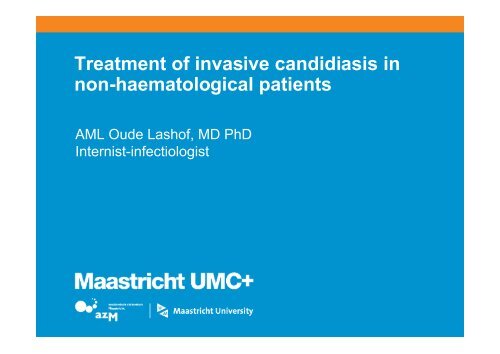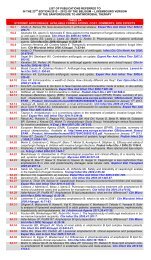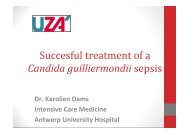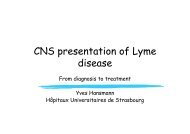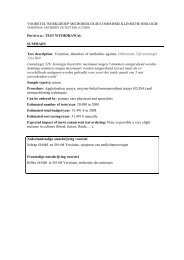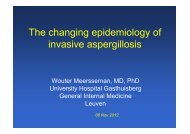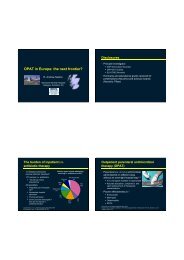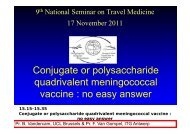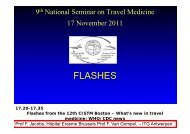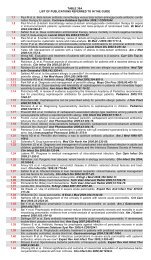Treatment of invasive candidiasis in non-haematological patients
Treatment of invasive candidiasis in non-haematological patients
Treatment of invasive candidiasis in non-haematological patients
- No tags were found...
You also want an ePaper? Increase the reach of your titles
YUMPU automatically turns print PDFs into web optimized ePapers that Google loves.
EpidemiologyMa<strong>in</strong>ly data from the USA or from <strong>in</strong>dividual EuropeancountriesTrick Cl<strong>in</strong> Infect Dis 2002
Candidemia <strong>in</strong>cidence <strong>in</strong> LeuvenLagrou, EJCMID 2007
Survival <strong>in</strong> candidemia, species relatedParapsilosisOther speciesAlbicansGlabrataTropicalisKruseiHorn Cl<strong>in</strong> Infect Dis 2009
Question1 : Which Candida species is mostfrequently cultured from blood next to C.albicans (<strong>in</strong> Belgium)?001 - C. glabrata2 - C. krusei3 - C. parapsilosis4 - C. tropicalis
Question1 : Which Candida species is mostfrequently cultured from blood next to C.albicans (<strong>in</strong> Belgium)?1 - C. glabrata0%2 - C. krusei0%3 - C. parapsilosis0%4 - C. tropicalis0%
| Advisory board Anidulafung<strong>in</strong>, Nov 8 th 2012Candida blood stream <strong>in</strong>fectionsMean 22% C. glabrata candidiaemiaWhat would you start as primary therapy?Lagrou, EJCMID 2007
Incidence and mortality <strong>of</strong> Candida Species<strong>in</strong> EuropePercentage <strong>patients</strong>80%70%60%50%40%30%20%10%0%56%37%50%14% 13%28%Candida speciesHospital mortality7%43%59%2% 1%25%C. albicans C. glabrata C. C. tropicalis C. krusei C. lusitaniaeparapsilosisTortorano, EJCMID 2004;23:317-22Wisp<strong>in</strong>gh<strong>of</strong>f, CID 2004;39:309-17
Time to start antifungal therapy& hospital mortalityMorrell M, et al. AAC 2005157 <strong>patients</strong> – 2001-2004Independent determ<strong>in</strong>ants <strong>of</strong> mortality:‣ APACHE II score (one-po<strong>in</strong>t <strong>in</strong>crements) (p 12 hoursafter the first positive blood culture (AOR, 2.09; p= 0.018)4035Crude mortality rate is high,the attributable mortality ratevaries between 5-71%!Falagas EJCMID 2006Hospital Mortality (%)Garey KW et al, CID 2006230 <strong>patients</strong>Independent determ<strong>in</strong>ants <strong>of</strong> mortality:‣ APACHE II score (∆1-pt.; p
HOW TO IDENTIFY PATIENTSAT RISK FOR CANDIDEMIA?
Question 2: Which factor has the greatest<strong>in</strong>dependent association with development<strong>of</strong> <strong><strong>in</strong>vasive</strong> <strong>candidiasis</strong> ?001 - Abdom<strong>in</strong>al surgery at basel<strong>in</strong>e2 - Multifocal colonization3 - Severe sepsis at basel<strong>in</strong>e4 - Total parenteral nutrition
Question 2: Which factor has the greatest<strong>in</strong>dependent association with development<strong>of</strong> <strong><strong>in</strong>vasive</strong> <strong>candidiasis</strong> ?1 - Abdom<strong>in</strong>al surgery at basel<strong>in</strong>e0%2 - Multifocal colonization0%3 - Severe sepsis at basel<strong>in</strong>e0%4 - Total parenteral nutrition0%
Prediction rules- Paphitou: TPN, hemodialysis, diabetes, broadspectrum antibiotics- Ostrosky-Zeichner:- CVC +/- broad spectrum antibioticsand at least 2 <strong>of</strong>:- TPN, hemodialysis, major surgery, pancreatitis,corticosteroids, immunosuppression- Candida score: Multivariate analysis <strong>of</strong> risk factorsthat predispose for <strong><strong>in</strong>vasive</strong> <strong>candidiasis</strong>
Identification <strong>of</strong> <strong>patients</strong>“Ostrosky rules”≥ 4 days on ICUAND-Antibiotics (d 1-3)OR-CVC (d 1-3)And at least 2 <strong>of</strong> theseTPN (d 1-3)Dialysis (d 1-3)Major surgery (d -7-0)Use steroids (d -7-3)Immunosupp. (d -7-0)Ostrosky-Zeichner, 2007;26:271
Identify <strong>patients</strong> for empirical/pre-emptive therapyDevelopment <strong>of</strong> “Candida score”1699 <strong>patients</strong>, ≥ 7 days on ICMultivariate analysis <strong>of</strong> risk factors for candidemiaweighto Colonization on multiple locations 1.112 1o TPN 0.908 1o Surgery at admission 0.997 1o Severe sepsis 2.038 2po<strong>in</strong>tsLeón, CCM 2006;34:730
Question3: What’s the problem withthe prediction rules to start empiricaltreatment?1 - High sensitivity, low specificity002 - Low sensitivity, high specificity3 - Only useful <strong>in</strong> high <strong>in</strong>cidence areas4 - 1+35 - 2+3
Question3: What’s the problem withthe prediction rules to start empiricaltreatment?1 - High sensitivity, low specificity0%2 - Low sensitivity, high specificity0%3 - Only useful <strong>in</strong> high <strong>in</strong>cidence areas 0%4 - 1+35 - 2+30%0%
Identification <strong>of</strong> <strong>patients</strong>“Ostrosky rules”≥ 4 days on ICUAND-Antibiotics (d 1-3)OR-CVC (d 1-3)And at least 2 <strong>of</strong> theseTPN (d 1-3)Dialysis (d 1-3)Major surgery (d -7-0)Use steroids (d -7-3)Immunosupp. (d -7-0)Sensitivity 34%, specificity 90%,PPV 1%, NPV 97%Prevalence 7% <strong><strong>in</strong>vasive</strong> <strong>candidiasis</strong>Ostrosky-Zeichner, 2007;26:271
Identify <strong>patients</strong> for empirical/pre-emptive therapyDevelopment <strong>of</strong> “Candida score”1699 <strong>patients</strong>, ≥ 7 days on ICMultivariate analysis <strong>of</strong> risk factors for candidemiao Colonization on multiple locations 1o TPN 1o Surgery at admission 1o Severe sepsis 2po<strong>in</strong>ts3: sensitivity 81%, specificity 74%PPV 16%, NPV 98%Prevalence 5.8%León, CCM 2006;34:730
Are the risk predictive models generalizable?Geographical variability <strong>in</strong> epidemiology <strong>of</strong> IC, case-mix &medical practicesValidation <strong>in</strong> Australia:Playford Int Care Med 2009
Question 4: Empirical treatment is most <strong>of</strong>ten<strong>in</strong>appropriate <strong>in</strong> septic ICU <strong>patients</strong> <strong>in</strong>fectedwith…001 - Staphylococcus aureus2 - Pseudomonas aerug<strong>in</strong>osa3 - Klebsiella species4 - Candida albicans
Question 4: Empirical treatment is most <strong>of</strong>ten<strong>in</strong>appropriate <strong>in</strong> septic ICU <strong>patients</strong> <strong>in</strong>fectedwith…1 - Staphylococcus aureus0%2 - Pseudomonas aerug<strong>in</strong>osa0%3 - Klebsiella species0%4 - Candida albicans0%
Appropriate empirical treatment <strong>in</strong> ICUKumar Chest 2009
HOW TO PREVENT INVASIVECANDIDIASIS IN THE ICU?
Antifungal prophylaxis <strong>in</strong> the ICU?Pro:-Reduces the <strong>in</strong>cidence <strong>of</strong><strong><strong>in</strong>vasive</strong> <strong>candidiasis</strong>!with app. 50%-Aga<strong>in</strong>: identification <strong>of</strong>target <strong>patients</strong> difficult-High risk <strong>patients</strong>-In high <strong>in</strong>cidence area-Necrotiz<strong>in</strong>g pancreatitis-Recurrent GI leakageCon:- Unselected ICUs: 1-2% <strong><strong>in</strong>vasive</strong><strong>candidiasis</strong>- In most hospitals;Ineffective strategy
Empirical antifungal therapy <strong>in</strong> ICURCT Prospective study <strong>in</strong> ICU <strong>patients</strong>Inclusion:•Unexpla<strong>in</strong>ed fever > 4 d•Broadspectrum antibiotics ≥ 4 d•APACHE-II score ≥ 16•CVC ≥ 1 d(no colonization criteria!) 14d Fluconazole (800mg/d) or placeboSchuster, Ann Intern Med. 2008
Outcome empirical therapy <strong>in</strong> ICUOutcome:•resolution <strong>of</strong> fever (72h)•no <strong><strong>in</strong>vasive</strong> mycosis•no discont<strong>in</strong>uation for toxicity•no other antifungal drugsTotal failures:55% vs 57%No resolution <strong>of</strong> fever51% vs 54%Fluconazole (122) Placebo (127)Success 34% 38% (0.69-1.32)Inv. Mycoses 5% 9% (0.22-1.49)Mortality 24% 17% (0.23-1.67)No effect <strong>of</strong> empirical fluconazole! Why?
TREATMENT OF INVASIVECANDIDIASIS
Time to start antifungal therapy& hospital mortalityMorrell M, et al. AAC 2005157 <strong>patients</strong> – 2001-2004Independent determ<strong>in</strong>ants <strong>of</strong> mortality:‣ APACHE II score (one-po<strong>in</strong>t <strong>in</strong>crements) (p 12 hoursafter the first positive blood culture (AOR, 2.09; p= 0.018)4035Crude mortality rate is high,the attributable mortality ratevaries between 5-71%!Falagas EJCMID 2006Hospital Mortality (%)Garey KW et al, CID 2006230 <strong>patients</strong>Independent determ<strong>in</strong>ants <strong>of</strong> mortality:‣ APACHE II score (∆1-pt.; p
Why do we choose whichantifungal drug?• Broad spectrum <strong>of</strong> antifungal activity• Efficacy• Patient characteristics• Safety / <strong>in</strong>teractions
Antifungal agentsAmphoteric<strong>in</strong> B• deoxycholate AmB• lipid formulationsEffective, broad spectrum,but toxicLipid: expensiveAzols• Fluconazole• voriconazoleEch<strong>in</strong>ocand<strong>in</strong>s• Casp<strong>of</strong>ung<strong>in</strong>• Anidulafung<strong>in</strong>• Micafung<strong>in</strong>Effective, less toxic, less broadspectrumInteractionsEffective, broad spectrumLittle toxicity, few <strong>in</strong>teractionsExpensive
Randomized Non-Inferior TrialsAmB vs fluconazole: equally effective (3 trials)AmB/fluc vs Fluc: equally effective Rex, 2003AmB -> fluc vs Vori: equally effective Kullberg, 2005Casp<strong>of</strong>ung<strong>in</strong> vs AmB: equally effective Mora-Duarte, 2002Micafung<strong>in</strong> vs L-AmB: equally effective Kuse, 2007Mica vs Caspo: equally effective Pappas, 2007Anidulafung<strong>in</strong> vs fluc: favours Anidula Reboli, 2007
SusceptibilityAntfungal Albicans Glabrata Parapsilosis TropicalisKruseiAmB-d S S S S SL-AmB S S S S SFluconazole S (SDD)-R S S Rvoriconazole S SDD-R S S SAnidulafung<strong>in</strong> S S S/? S SCasp<strong>of</strong>ung<strong>in</strong> S S S/? S Smicafung<strong>in</strong> S S S/? S S
Casp<strong>of</strong>ung<strong>in</strong> vs. Amphoteric<strong>in</strong> B trialTime to First Negative Blood Culture100%90Casp<strong>of</strong>ung<strong>in</strong>70/50 mgAmphoteric<strong>in</strong> B0.6-1.0 mg/kg8070605040302010Success (MITT) 73% 62% P=0.09n=224Crude Mortality 34% 30% P=0.53ToxicityDiscont<strong>in</strong>uations3% 23% P=0.03Casp<strong>of</strong>ung<strong>in</strong> (N=92)Amphoteric<strong>in</strong> B (N=94)00 1 2 3 4 5 6 7 8 9 10 11 12 13 14 15 16 17 18 19 20 21 22 23 24STUDY DAYMora-Duarte NEJM2002
Casp<strong>of</strong>ung<strong>in</strong> vs. AmB <strong>in</strong> ICU Patients (n=97)68%56%Response Rates45%40%5%11%DiNubile Crit Care 2007
Micafung<strong>in</strong> vs. L-AmB <strong>in</strong> ICU Patients (n=230)Dupont Crit Care 2009
Micafung<strong>in</strong> vs. L-AmB <strong>in</strong> ICU Patients (n=230)63% 66% 38% p=n.s.34%Dupont Crit Care 2009
Anidulafung<strong>in</strong> vs. fluconazole studyMITTpopulationAnidulafung<strong>in</strong> Fluconazole DifferenceN=127 (%) N=118 (%) 95% CISuccess EIV 96 (75.6) 71 (60.2) 15.4 (3.9-27.0)(p
Survival <strong>in</strong> ICU <strong>patients</strong>:anidulafug<strong>in</strong> vs fluconazoleKett, Int J Antimicr Ag 2008
Success rates different ech<strong>in</strong>ocand<strong>in</strong>sGlöckner Mycoses2009
Indications per ech<strong>in</strong>ocand<strong>in</strong>Wagner, Pharmacology 2006
Question 5: Should the <strong>in</strong>travascularcatheters be removed < 24h? 001 - Yes, when > 24h mortality is higher2 - No, but < 48h; > 48h mortality is higher3 - No, but it should be removed4 - Removal <strong>of</strong> the catheter has no effect on mortality
Question 5: Should the <strong>in</strong>travascularcatheters be removed < 24h?1 - Yes, when > 24h mortality is higher0%2 - No, but < 48h; > 48h mortality is higher 0%3 - No, but it should be removed0%4 - Removal <strong>of</strong> the catheter has noeffect on mortality0%
Antifungal agents and survivalCandidemia and <strong><strong>in</strong>vasive</strong> <strong>candidiasis</strong>•7 randomized controlled trials•7 antifungal agents (flu, vori, amB, L-amB, caspo,anidula, mica)•New analysis <strong>of</strong> all <strong>in</strong>dividual <strong>patients</strong>•Primary endpo<strong>in</strong>t: 30 day survival•Exclud<strong>in</strong>g: comb<strong>in</strong>ation therapy, unknown candidaspecies, multiple species <strong>in</strong>fection•1915 <strong>patients</strong>!Andes Cl<strong>in</strong> Infect Dis 2012
Andes pooled data analysis1915 <strong>patients</strong>, two polyenes, two triazoles, three cand<strong>in</strong>sLogistic regression us<strong>in</strong>g 30-day mortality as primary outcomeIncreased mortality• Age• APACHE II• Immunosuppressive therapy• C. tropicalisDecreased mortality• CVC removal dur<strong>in</strong>g therapy• Ech<strong>in</strong>ocand<strong>in</strong> antifungal"These results support first-l<strong>in</strong>e treatment withan ech<strong>in</strong>ocand<strong>in</strong> to the majority <strong>of</strong> <strong>patients</strong>”Similar risk factors by subgroup: C. albicans, C. glabrata,all <strong>non</strong>-albicansAndes et al., Cl<strong>in</strong> Infect Dis 2012
In conclusion• Invasive <strong>candidiasis</strong> still has a high mortality rate• Antifungal prophylaxis <strong>in</strong> ICU is effective but<strong>in</strong>appropriate• Empirical antifungal therapy <strong>in</strong> ICU is not proveneffective• Prediction rules to start pre-emptive therapy have ahign NPV, and a reasonable specificity. Especiallyuseful <strong>in</strong> high <strong>in</strong>cidence areas/<strong>patients</strong>• Intravascular catheters should be removed/replacedwhenever feasible• <strong>Treatment</strong> with an ech<strong>in</strong>ocand<strong>in</strong> is preferred, for thehigher response rate
<strong>Treatment</strong> <strong>of</strong> <strong><strong>in</strong>vasive</strong> <strong>candidiasis</strong> <strong>in</strong><strong>non</strong>-<strong>haematological</strong> <strong>patients</strong>AML Oude Lash<strong>of</strong>, MD PhDInternist-<strong>in</strong>fectiologist
<strong>Treatment</strong> <strong>of</strong> candidemia-Candida species and susceptibility-Localization <strong>of</strong> <strong>in</strong>fection- Candidemia only- Dissem<strong>in</strong>ated disease-Mode <strong>of</strong> adm<strong>in</strong>istration-Duration <strong>of</strong> candidemia-…
Empirical treatment is most <strong>of</strong>ten<strong>in</strong>appropriate <strong>in</strong> septic ICU <strong>patients</strong><strong>in</strong>fected with…1.Staphylococcus aureus2.Pseudomonas aerug<strong>in</strong>osa3.Klebsiella species4.Candida albicans
Success at EIV treatment by pathogenDifference driven by C. albicans <strong>in</strong>fections!% Success75.6%∆15.4%P=0.00960.2%81.1%∆18.8%P=0.01562.3%Anidulafung<strong>in</strong>Fluconazole71.1%∆11.1%P=0.2660.0%All <strong>patients</strong>n=60 n=38 n=32 n=27C. albicans(N=74)(N=61)Non-albicans(N=45)(N=45)* Patients with a s<strong>in</strong>gle basel<strong>in</strong>e pathogenReboli NEJM 2007
Question 6: Should the <strong>in</strong>travascularcatheters be removed < 24h? 001 - Yes, when > 24h mortality is higher2 - No, but < 48h; > 48h mortality is higher3 - No, but it should be removed4 - Removal <strong>of</strong> the catheter has no effect on mortality
Question 6: Should the <strong>in</strong>travascularcatheters be removed < 24h?1 - Yes, when > 24h mortality is higher0%2 - No, but < 48h; > 48h mortality is higher 0%3 - No, but it should be removed0%4 - Removal <strong>of</strong> the catheter has noeffect on mortality0%
MortalityCrude mortality rate is high,the attributable mortality ratevaries between 5-71% depend<strong>in</strong>gon the studyMorrell AAC 2005, Kumar Chest 2009
Candida Score<strong>in</strong> practiceProspective observational multicenter study•≥7 days IC with multifocal colonization (1)•TPN(1)•Surgery (1)•Sepsis(2)Goal:
Results Candida Score<strong>in</strong> practice1107 <strong>patients</strong>892: colonized / <strong>in</strong>fected• 565: CS 13 (2.3%) <strong><strong>in</strong>vasive</strong> Candida <strong>in</strong>fection• 327: CS ≥3 -> 45 (13.8%) <strong><strong>in</strong>vasive</strong> Candida <strong>in</strong>fectionLeón, CCM 2009;37:1624


